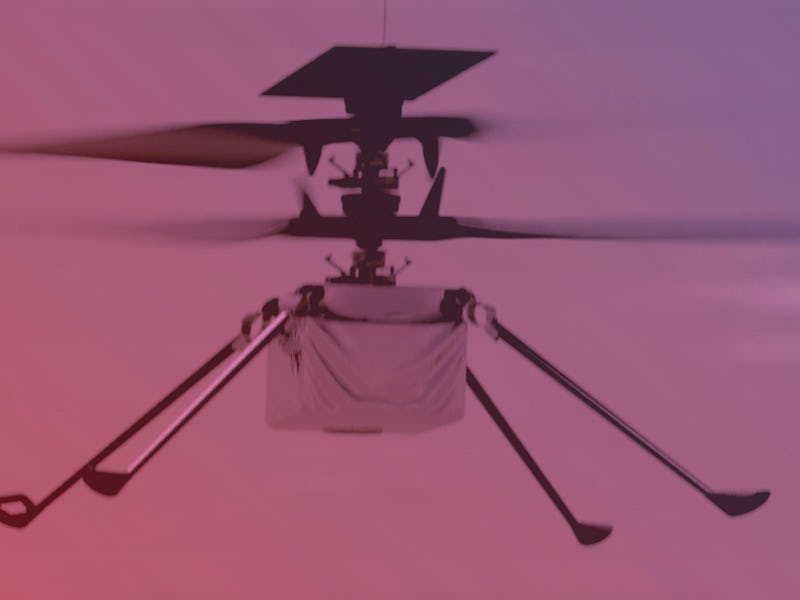Inverse Daily: What if Ingenuity fails?
Plus: Two different studies about monkeys and apes shed light on why humans act the way they do.

Ingenuity, the Mars helicopter, is going to conduct its first flight on the Red Planet very early Monday, a first for humanity regarding a controlled flight on another planet.
But what if the harsh climate of the alien planet is unforgiving? To put it another way, what if the $85 million project that traveled 293 million miles to Mars breaks down?
The answers to that story and more are in this edition of Inverse Daily, the award-winning daily newsletter from Inverse. I’m Nick Lucchesi, editor-in-chief, and privileged colleague of the writers who brought you the stories below.
This is an adapted version of the Inverse Daily newsletter for April 9, 2021. Subscribe for free and earn rewards for reading every day in your inbox.
An artist’s rendering of the Ingenuity Mars helicopter whirling its propellers above the Perseverance rover.
What if Ingenuity fails? — The Ingenuity helicopter is gearing up for flight on Mars, but what happens if it doesn't pass this crucial test? Passant Rabie explores that question via interviews and brings back this report:
The aircraft is gearing up for its first test flight, slated for some time Sunday. It will mark the first human-controlled flight to take place on another planet and open up new ways for planetary exploration.
However, should its four legs never leave the Martian ground, engineers will have to go back to the drawing board on otherworldly powered flights — with Ingenuity as just the first on the horizon.
More like this:
- First color Ingenuity photos and more: Understand the world through 8 images
- Ingenuity first Mars flight: NASA teases date, time, and how to watch
- Watch the Mars helicopter unpack its tiny legs
Scientists decode how gorillas talk to each other — Gorillas are known for their distinctive habit of beating their chests, and scientists now think they know the message behind the drumming, reports Bryan Lawver.
You’ve almost certainly seen an image of a gorilla beating its chest at some point. It’s one of the ape’s most distinctive behaviors. Scientists have long thought that gorillas beat their chests to communicate with each other. However, they didn’t know exactly what was being communicated — or how.
But that has now changed.
More like this:
- Western lowland gorillas: 2 massive reasons why we need to save them
- Eerily human trait suggests gorillas aren't as chill as we thought
- Gorilla cliques mirror human relationships in one very relatable way
Scientists just reinvented the wheel. See how it works — A new study lays out how an origami-inspired, shape-shifting tire could fundamentally change how we roll, writes Jordan Golson.
Thousands of years ago, the invention of the wheel rolled humans toward civilization. While it has gone through some minor changes over the course of history in terms of use (the first wheels might have been used to make pottery rather than for transport) and materials, the basic concept itself supposedly cannot be improved upon.
Except, perhaps it can.
More like this:
- The 4 best tablet car mounts
- See the electric pickup trucks that will give Tesla Cybertruck competition
- The 3 best steering wheel covers
Sex between humans and Neanderthals was way more common than realized — Two studies published Wednesday in the journal Nature provide much-needed insight into how ancient humans interacted nearly 45,000 to 35,000 years ago, reports Sarah Sloat.
Thousands of years ago, the lives of two different species of humans were forever changed by two distinctly different events.
During the Middle to Upper Palaeolithic transition, anatomically modern humans — Homo sapiens (that’s us) — started to migrate across Eurasia. Neanderthals, meanwhile, started to disappear.
“For a very long time, it has been intensively debated on how these processes exactly occurred,” Mateja Hajdinjak tells Inverse. Hajdinjak is an associate researcher at the Max Planck Institute for Evolutionary Anthropology and an expert in ancient genomics.
A study co-authored by Hajdinjak and published Wednesday in the journal Nature — alongside another ancient humans study also published Wednesday in Nature — finally provides much-needed insight into what happened nearly 45,000 to 35,000 years ago.
More like this:
- When did the last Neanderthal die?
- Neanderthal DNA may influence your Covid-19 risk
- Study reveals what Neanderthal babies might've looked like
One monkey trick could help you survive a disaster — Researchers have discovered that rhesus macaques formed new social bonds in the wake of Hurricane Maria in Puerto Rico, reports Tara Yarlagadda.
Before Hurricane Maria devastated Puerto Rico, the macaques living on Cayo Santiago existed in a state of tolerable anarchy.
But the disaster brought the monkeys together in unexpected new ways — showing that extensive social connections serve an important scientific purpose.
More like this:
- Counterintuitive study reveals one strange result of human evolution
- Primate study finds a scandalous similarity to humans
- Scientists decode how gorillas talk to each other
That wraps up this edition of Inverse Daily. I would like to thank you for reading so loyally! You can follow me on Twitter at @nicklucchesi, where I share some of my favorite stories from Inverse, Input, and Mic every day.